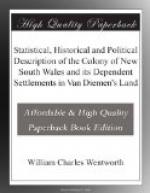Beyond this barren waste, which thus forms a girdle to the coast, the country suddenly begins to improve. The soil changes to a thin layer of vegetable mould, resting on a stratum of yellow clay, which is again supported by a deep bed of schistus. The trees of the forest are here of the most stately dimensions. Full sized gums and iron barks, along side of which the loftiest trees in this country would appear as pigmies, with the beefwood tree, or as it is generally termed, the forest oak, which is of much humbler growth, are the usual timber. The forest is extremely thick, but there is little or no underwood. A poor sour grass, which is too effectually sheltered from the rays of the sun, to be possessed of any nutritive and fattening properties, shoots up in the intervals. This description of country, with a few exceptions, however, which deserve not to be particularly noticed, forms another girdle of about ten miles in breadth: so that, generally speaking, the colony for about sixteen miles into the interior, may be said to possess a soil, which has naturally no claim to fertility, and will require all the skill and industry of its owners to render it even tolerably productive.
At this distance, however, the aspect of the country begins rapidly to improve. The forest is less thick, and the trees in general are of another description; the iron barks, yellow gums, and forest oaks disappearing, and the stringy barks, blue gums, and box trees, generally usurping their stead. When you have advanced about four miles further into the interior, you are at length gratified with the appearance of a country truly beautiful. An endless variety of hill and dale, clothed in the most luxuriant herbage, and covered with bleating flocks and lowing herds, at length indicate that you are in regions fit to be inhabited by civilized man. The soil has no longer the stamp of barrenness. A rich loam resting on a substratum of fat red clay, several feet in depth, is found even on the tops of the highest hills, which in general do not yield in fertility to the vallies. The timber, strange as it may appear, is of inferior size, though still of the same nature, i. e. blue gum, box, and stringy bark. There is no underwood, and the number of trees upon an acre do not upon an average exceed thirty. They are, in fact, so thin, that a person may gallop without difficulty in every direction. Coursing the kangaroo is the favourite amusement of the colonists, who generally pursue this animal at full speed on horseback, and frequently manage, notwithstanding its extraordinary swiftness, to be up at the death; so trifling are the impediments occasioned by the forest.




